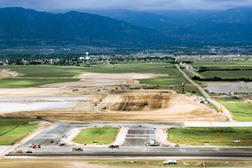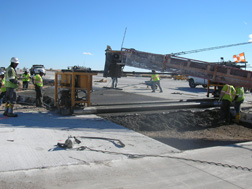Peterson Air Force Base – A/DACG Facility
Project Focus
 |
Project Details
Schedule & Complexity
In order to construct the Infield Military Operational Surface (IMOS) Hot Cargo Pads, parking areas for aircraft holding missiles, it was necessary to utilize space inside the area of operations (AOA) of the Colorado Springs Airport. Because another contract was underway to reconstruct the Main Runway at the Airport, this required close coordination with Airport Operations personnel, as well as other construction activity in the same area. To prepare for the paving, an excess of 1 million yards of dirt was imported to bring the construction area up to grade. While moving this dirt, a rubble field of approximately 38,000 yards was uncovered and required removal. Multiple drainage structures and extensive utilities were also incorporated in the project. Scheduling delays were encountered coordinating with Colorado Springs Utilities. The Contractor was able to minimize the impact of the scheduling by coordination with the Colorado Springs Airport Operations and military live load operations.
 |
Construction & Innovation
The original specifications called for the paving to be completed in 20’ widths. The Contractor proposed completing 40’ widths constructed in a pilot and filler configuration. The Corps was skeptical at first, as they demanded the slab edges be a true 90 degrees. The Contractor proved the ability to place the 40’ widths with perfect edges, and was able to cut the paving time in half. In a value-engineering proposal, over 330,000 tons of recycled concrete from the recently demolished Airport runway was used as embankment, and was used along with cement-treated sand to save time in the embankment and base construction.
The Contractor proposed, and the Owner approved 2 value engineering proposals worth $1,224,130 for base and pipe operations. The Contractor brought in a Crusher to crush 86,000 tons of subbase from recycled concrete. Additionally, the Contractor utilized a Soff-cut saw operation on 33,000 lf of filler lane transverse joints to minimize the risk of “sympathy” cracking.
Quality
The U. S. Army Corps of Engineers has a Quality Control Program renowned for its stringency. The Contractor sent two employees to a Corps training class for certification in the Corps Quality Control System. These employees then worked with the Contractor’s Quality Control Manager and team members in performing quality control testing. In addition, the Contractor hired an outside geotechnical laboratory to perform separate, independent testing.
 |
Public Relations
Since this project was constructed within the confines of Peterson Air Force Base and the Colorado Springs Airport, the general public really was not impacted. The access to the construction site was off of Powers Boulevard. The Contractor constructed a turn lane from Powers to the access road. Gate guards were positioned to prevent any non-construction or unauthorized vehicles entering the construction area.